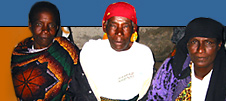|
||
 |

|
 |
|
|
From Boiling Discord to Spider Eggs (A community looks at its environmental issues
together) Tuolumne County, CA, USA, 1997: One would never suspect that beneath the surface of Sonora, a historic gold-rush town nestled in the foothills of California's Sierra Nevada mountains, was a boiling core of discord. Timber, economic development and environmental interests were in constant battle. The issues were intense; sides were clearly drawn. People had become known for their "positions," and relationships had long since deteriorated. This small community was living a reality experienced in most of the forested West. Eventually, two county supervisors got together and decided that it was time for people to find a way to work together. The path led to the formation of a planning committee of concerned citizens, whose task was to bring people together to explore whether there was some point of mutuality that would allow community members to work collaboratively. They chose to use the future search conference model, believing that it might enable them to accomplish their mission. Members of this committee worked for nine months to overcome their own deep-seated mistrust of each other, find a focus of the conference, search for funding, and reduce the initial participant list from 400 to 80. They eventually decided to "heal" the community first, prior to tackling such difficult issues as watershed management. Thus the conference focus became "Our Back Yard (OBY), Tuolumne County in 2020." The committee's common ground became the conference - and the healing had begun. So it was that in April, 1997, a diverse and representative group of concerned citizens came together to develop a common ground vision for Tuolumne County. During the future search, the roller coaster ride was "wild." A rich history, a complex and chaotic present, somewhat tentative future scenarios, and a contentious reality dialogue all set the stage for the development of truly visionary statements of common ground and highly energized action planning groups. The future search closing was deeply moving, with individuals sharing their own personal commitments. One participant, a logger, revealed that he "came to this meeting with a problem. That problem is always being right. My commitment is to listen to others who have other opinions than I do…knowing that they're right, too." The healing had expanded and deepened. What Happened Later A year and a half later, OBY committee had grown to include new members from the conference and some from the community who were not involved with the future search. After the conference, the committee struggled with its mission, its identity, and its purpose. But the group persisted. Amazingly, big and little things have occurred. The Natural Resource Group formed at the future search as an action planning team (made up of natural resource users and environmentalists), is alive and well and working on a project with the U.S. Forest Service. Another group has developed a curriculum on collaboration skills to build the capacity of citizens to work together in the community. A leader in the environmental community has become a member of the Chamber of Commerce. Future search managers Susan Dupre, Lisa Beutler and Leslie DePol went back to convene participants and other citizens to discover some of the intended and unintended outcomes of the conference. Some expressed disappointment over the fact that there seemed to be litle or no follow-through on some action plans. Others pointed to a couple of groups moving forward and still others were aware of a great number of changes in people and in the community which they described as being loosely connected by threads that are sometimes barely (if at all) visible and which are "web-like" in nature. As people shared their perceptions, the "whole elephant" became visible and present again. In trying to understand the impact of the future search on the community, one OBY committee member commented, "It's no longer about the future search and who was there and who wasn't. The conference was like a spider laying eggs, which then got dispersed. Some of them fell in the barn and we can see and nurture their growth. Others were blown by the wind outside and we just don't know where they'll land and what will come from them. The OBY steering committee recently heard that they have received an award from the USDA Forest Service with a $5000 grant attached. They agree that this will provide them with a needed boost to continue their mission - to nourish the spirit of collaboration in Tuolumne County. |
|
|
|
home | introducing
the method | what is future search? | conditions for success | methodology |